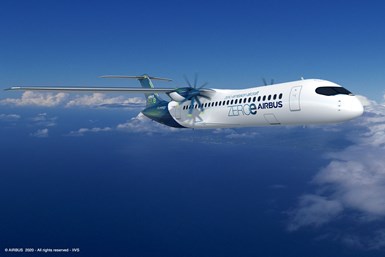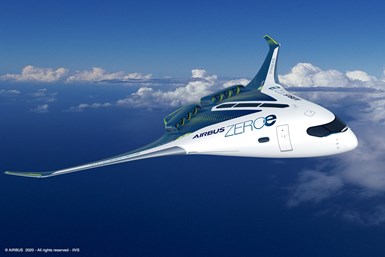Airbus reveals new zero-emission concept aircraft
The three concepts — all codenamed ZEROe — each represent a different approach to achieving zero-emission flight. The aircraft could enter service by 2035.

Airbus' ZEROe concept aircraft. Photo Credit: Airbus
Airbus (Toulouse, France) revealed on Sept. 21 three concepts for what the company says is the world’s first zero-emission commercial aircraft which could enter service by 2035. These concepts, says Airbus, each represent a different approach to achieving zero-emission flight, exploring various technology pathways and aerodynamic configurations in order to support the its ambition of leading the way in the decarbonization of the entire aviation industry.
All of these concepts rely on hydrogen as a primary power source — an option which Airbus believes holds promise as a clean aviation fuel and is likely to be a solution for aerospace and many other industries to meet climate-neutral targets.
The three concepts — all codenamed “ZEROe” — for the first climate neutral zero-emission commercial aircraft include:

Turbofan design concept. Photo Credit: Airbus
- A turbofan design (120-200 passengers) with a range of 2,000+ nautical miles, capable of operating trans-continentally and powered by a modified gas-turbine engine running on hydrogen, rather than jet fuel, through combustion. The liquid hydrogen will be stored and distributed via tanks located behind the rear pressure bulkhead.
-

Turboprop design. Photo Credit: Airbus
A turboprop design (up to 100 passengers) using a turboprop engine instead of a turbofan and also powered by hydrogen combustion in modified gas-turbine engines, which would be capable of traveling more than 1,000 nautical miles, making it a perfect option for short-haul trips.
- A “blended-wing body” design (up to 200 passengers) concept in which
the wings merge with the main body of the aircraft with a range similar to that of the turbofan concept. The exceptionally wide fuselage opens up multiple options for hydrogen storage and distribution, and for cabin layout.

Blended-wing body design concept. Photo Credit: Airbus
“The transition to hydrogen, as the primary power source for these concept planes, will require decisive action from the entire aviation ecosystem,” says Guillaume Faury, Airbus CEO. “Together with the support from government and industrial partners we can rise up to this challenge to scale-up renewable energy and hydrogen for the sustainable future of the aviation industry.”
In order to tackle these challenges, says Airbus, airports will require significant hydrogen transport and refueling infrastructure to meet the needs of day-to-day operations. Support from governments will be key to meet these ambitious objectives with increased funding for research and technology, digitalization, and mechanisms that encourage the use of sustainable fuels and the renewal of aircraft fleets to allow airlines to retire older, less environmentally friendly aircraft earlier.
Related Content
-
JEC World 2023 highlights: Innovative prepregs, bio-resins, automation, business development
CW’s Jeff Sloan checks in with JEC innovations from Solvay, A&P, Nikkiso, Voith, Hexcel, KraussMaffei, FILL, Web Industries, Sicomin, Bakelite Synthetics, Westlake Epoxy and Reliance Industries.
-
UniFORM: High-quality, high-complex EV battery enclosures at low cycle times, low tooling costs
Stellantis subsidiary CpK Interior Products Inc. recently completed a design challenge to prove out its vacuum-assisted wet compression molding process for CFRP battery trays.
-
High-performance, high-detail continuous 3D-printed carbon fiber parts
Since 2014, Mantis Composites has built its customer and R&D capabilities specifically toward design, printing and postprocessing of highly engineered aerospace and defense parts.
















